Science Lesson Plans: Detailed Curriculum for Plant and Platypus Study
VerifiedAdded on 2020/05/16
|16
|3711
|170
Homework Assignment
AI Summary
This document presents detailed science lesson plans designed for students in Years 3-6, covering key concepts in biology and earth science. The lesson plans are structured around the Australian Curriculum, incorporating general capabilities like literacy and cross-curriculum priorities such as Aboriginal and Torres Strait Islander histories and cultures, Asia and Australia’s engagement with Asia, and sustainability. The lesson plans focus on plant growth, including germination, and the platypus life cycle, including its birth, care of young, habitat, and food habits. Each lesson plan includes intended learning outcomes, students' prior knowledge, materials, lesson steps, key questions, and assessment methods. The plans use an engage, explore, explain, elaborate, and evaluate framework to facilitate student understanding. The document emphasizes the application of scientific knowledge, scientific inquiry skills, and the nature and development of science. The provided lesson plans align with specific science understanding, science as a human endeavor, and science inquiry skills. These plans are designed to help students understand life cycles, material properties, and Earth's processes. The document also includes links to assessment rubrics and resources.
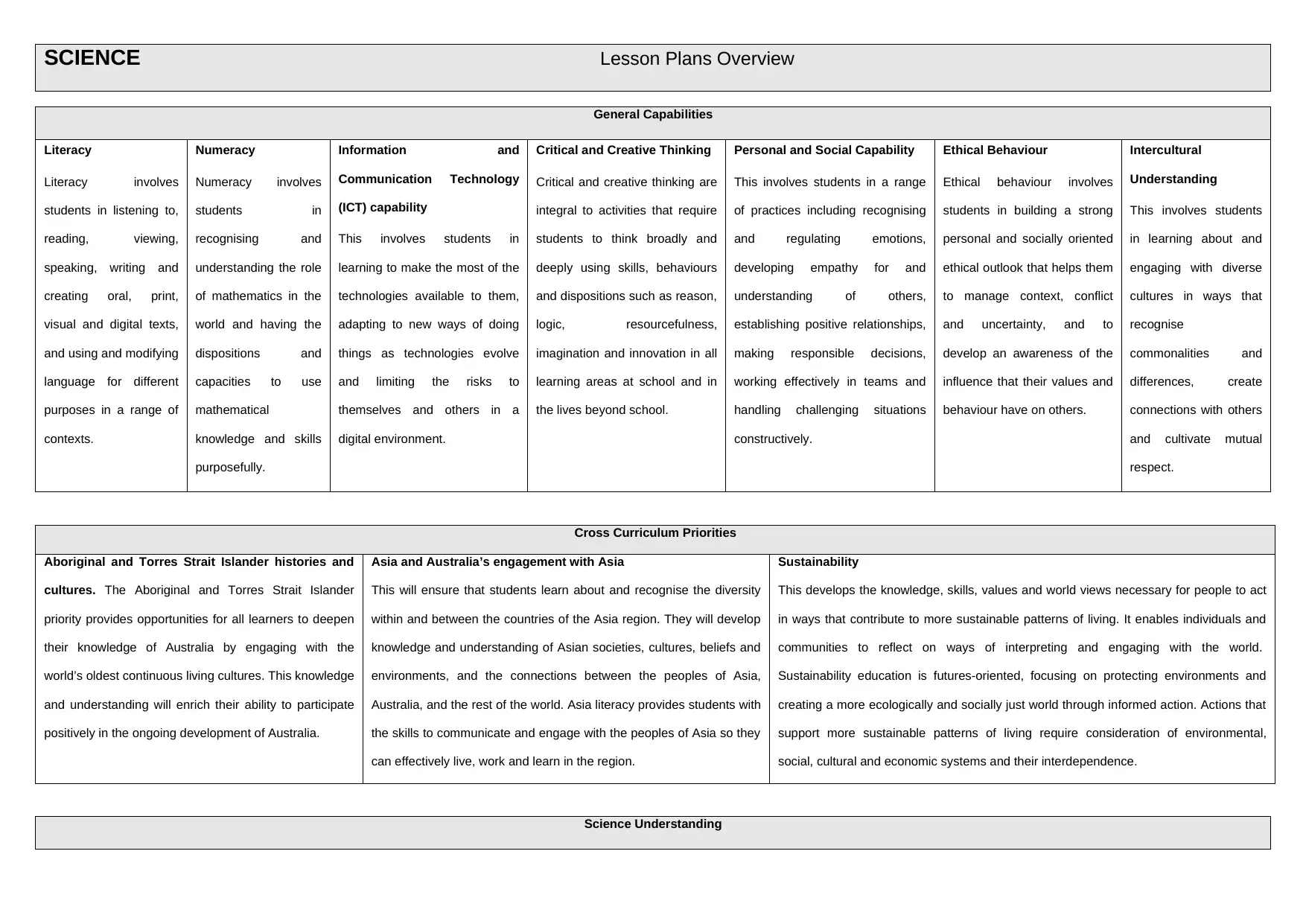
SCIENCE Lesson Plans Overview
General Capabilities
Literacy
Literacy involves
students in listening to,
reading, viewing,
speaking, writing and
creating oral, print,
visual and digital texts,
and using and modifying
language for different
purposes in a range of
contexts.
Numeracy
Numeracy involves
students in
recognising and
understanding the role
of mathematics in the
world and having the
dispositions and
capacities to use
mathematical
knowledge and skills
purposefully.
Information and
Communication Technology
(ICT) capability
This involves students in
learning to make the most of the
technologies available to them,
adapting to new ways of doing
things as technologies evolve
and limiting the risks to
themselves and others in a
digital environment.
Critical and Creative Thinking
Critical and creative thinking are
integral to activities that require
students to think broadly and
deeply using skills, behaviours
and dispositions such as reason,
logic, resourcefulness,
imagination and innovation in all
learning areas at school and in
the lives beyond school.
Personal and Social Capability
This involves students in a range
of practices including recognising
and regulating emotions,
developing empathy for and
understanding of others,
establishing positive relationships,
making responsible decisions,
working effectively in teams and
handling challenging situations
constructively.
Ethical Behaviour
Ethical behaviour involves
students in building a strong
personal and socially oriented
ethical outlook that helps them
to manage context, conflict
and uncertainty, and to
develop an awareness of the
influence that their values and
behaviour have on others.
Intercultural
Understanding
This involves students
in learning about and
engaging with diverse
cultures in ways that
recognise
commonalities and
differences, create
connections with others
and cultivate mutual
respect.
Cross Curriculum Priorities
Aboriginal and Torres Strait Islander histories and
cultures. The Aboriginal and Torres Strait Islander
priority provides opportunities for all learners to deepen
their knowledge of Australia by engaging with the
world’s oldest continuous living cultures. This knowledge
and understanding will enrich their ability to participate
positively in the ongoing development of Australia.
Asia and Australia’s engagement with Asia
This will ensure that students learn about and recognise the diversity
within and between the countries of the Asia region. They will develop
knowledge and understanding of Asian societies, cultures, beliefs and
environments, and the connections between the peoples of Asia,
Australia, and the rest of the world. Asia literacy provides students with
the skills to communicate and engage with the peoples of Asia so they
can effectively live, work and learn in the region.
Sustainability
This develops the knowledge, skills, values and world views necessary for people to act
in ways that contribute to more sustainable patterns of living. It enables individuals and
communities to reflect on ways of interpreting and engaging with the world.
Sustainability education is futures-oriented, focusing on protecting environments and
creating a more ecologically and socially just world through informed action. Actions that
support more sustainable patterns of living require consideration of environmental,
social, cultural and economic systems and their interdependence.
Science Understanding
General Capabilities
Literacy
Literacy involves
students in listening to,
reading, viewing,
speaking, writing and
creating oral, print,
visual and digital texts,
and using and modifying
language for different
purposes in a range of
contexts.
Numeracy
Numeracy involves
students in
recognising and
understanding the role
of mathematics in the
world and having the
dispositions and
capacities to use
mathematical
knowledge and skills
purposefully.
Information and
Communication Technology
(ICT) capability
This involves students in
learning to make the most of the
technologies available to them,
adapting to new ways of doing
things as technologies evolve
and limiting the risks to
themselves and others in a
digital environment.
Critical and Creative Thinking
Critical and creative thinking are
integral to activities that require
students to think broadly and
deeply using skills, behaviours
and dispositions such as reason,
logic, resourcefulness,
imagination and innovation in all
learning areas at school and in
the lives beyond school.
Personal and Social Capability
This involves students in a range
of practices including recognising
and regulating emotions,
developing empathy for and
understanding of others,
establishing positive relationships,
making responsible decisions,
working effectively in teams and
handling challenging situations
constructively.
Ethical Behaviour
Ethical behaviour involves
students in building a strong
personal and socially oriented
ethical outlook that helps them
to manage context, conflict
and uncertainty, and to
develop an awareness of the
influence that their values and
behaviour have on others.
Intercultural
Understanding
This involves students
in learning about and
engaging with diverse
cultures in ways that
recognise
commonalities and
differences, create
connections with others
and cultivate mutual
respect.
Cross Curriculum Priorities
Aboriginal and Torres Strait Islander histories and
cultures. The Aboriginal and Torres Strait Islander
priority provides opportunities for all learners to deepen
their knowledge of Australia by engaging with the
world’s oldest continuous living cultures. This knowledge
and understanding will enrich their ability to participate
positively in the ongoing development of Australia.
Asia and Australia’s engagement with Asia
This will ensure that students learn about and recognise the diversity
within and between the countries of the Asia region. They will develop
knowledge and understanding of Asian societies, cultures, beliefs and
environments, and the connections between the peoples of Asia,
Australia, and the rest of the world. Asia literacy provides students with
the skills to communicate and engage with the peoples of Asia so they
can effectively live, work and learn in the region.
Sustainability
This develops the knowledge, skills, values and world views necessary for people to act
in ways that contribute to more sustainable patterns of living. It enables individuals and
communities to reflect on ways of interpreting and engaging with the world.
Sustainability education is futures-oriented, focusing on protecting environments and
creating a more ecologically and socially just world through informed action. Actions that
support more sustainable patterns of living require consideration of environmental,
social, cultural and economic systems and their interdependence.
Science Understanding
Paraphrase This Document
Need a fresh take? Get an instant paraphrase of this document with our AI Paraphraser
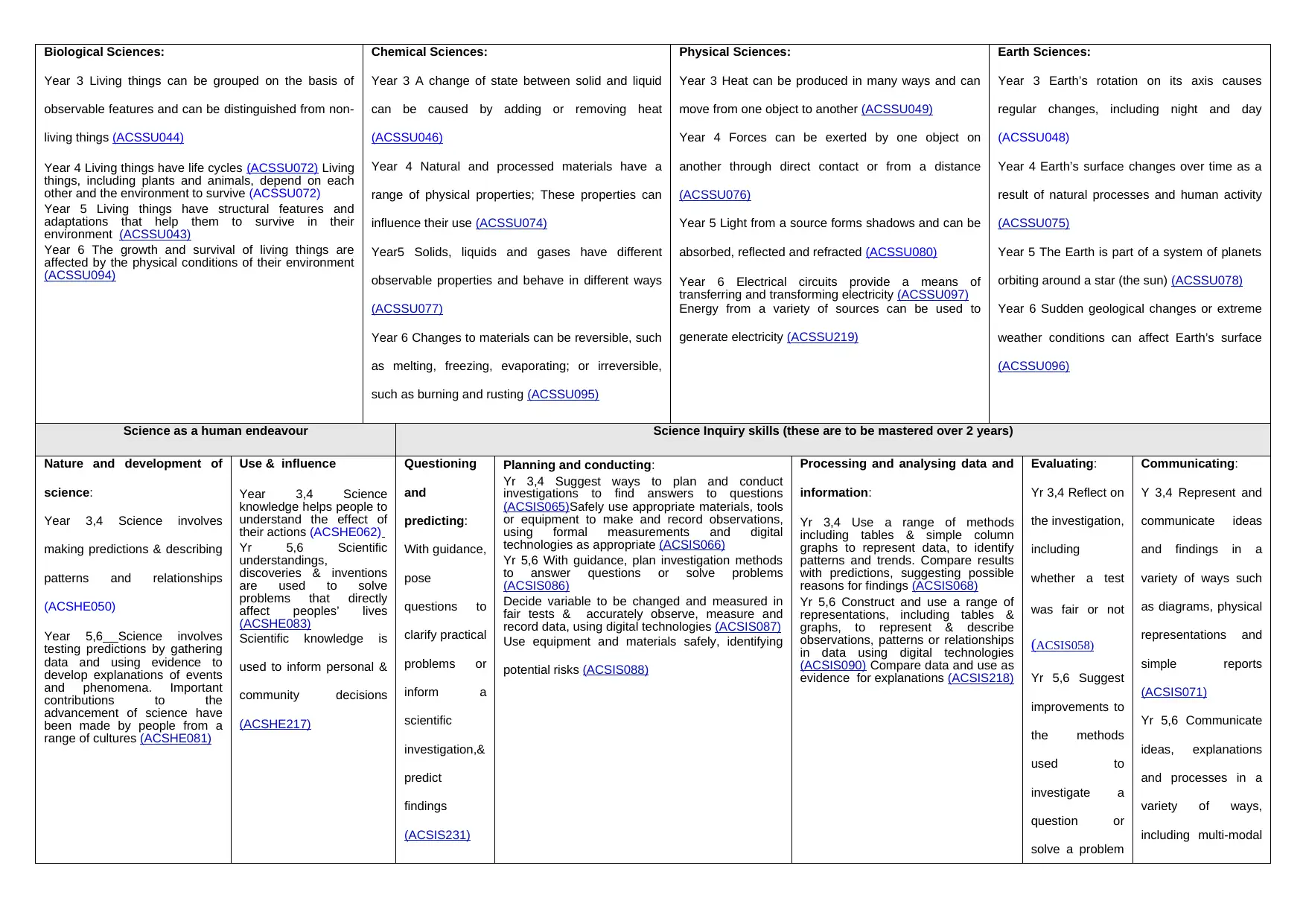
Biological Sciences:
Year 3 Living things can be grouped on the basis of
observable features and can be distinguished from non-
living things (ACSSU044)
Year 4 Living things have life cycles (ACSSU072) Living
things, including plants and animals, depend on each
other and the environment to survive (ACSSU072)
Year 5 Living things have structural features and
adaptations that help them to survive in their
environment (ACSSU043)
Year 6 The growth and survival of living things are
affected by the physical conditions of their environment
(ACSSU094)
Chemical Sciences:
Year 3 A change of state between solid and liquid
can be caused by adding or removing heat
(ACSSU046)
Year 4 Natural and processed materials have a
range of physical properties; These properties can
influence their use (ACSSU074)
Year5 Solids, liquids and gases have different
observable properties and behave in different ways
(ACSSU077)
Year 6 Changes to materials can be reversible, such
as melting, freezing, evaporating; or irreversible,
such as burning and rusting (ACSSU095)
Physical Sciences:
Year 3 Heat can be produced in many ways and can
move from one object to another (ACSSU049)
Year 4 Forces can be exerted by one object on
another through direct contact or from a distance
(ACSSU076)
Year 5 Light from a source forms shadows and can be
absorbed, reflected and refracted (ACSSU080)
Year 6 Electrical circuits provide a means of
transferring and transforming electricity (ACSSU097)
Energy from a variety of sources can be used to
generate electricity (ACSSU219)
Earth Sciences:
Year 3 Earth’s rotation on its axis causes
regular changes, including night and day
(ACSSU048)
Year 4 Earth’s surface changes over time as a
result of natural processes and human activity
(ACSSU075)
Year 5 The Earth is part of a system of planets
orbiting around a star (the sun) (ACSSU078)
Year 6 Sudden geological changes or extreme
weather conditions can affect Earth’s surface
(ACSSU096)
Science as a human endeavour Science Inquiry skills (these are to be mastered over 2 years)
Nature and development of
science:
Year 3,4 Science involves
making predictions & describing
patterns and relationships
(ACSHE050)
Year 5,6 Science involves
testing predictions by gathering
data and using evidence to
develop explanations of events
and phenomena. Important
contributions to the
advancement of science have
been made by people from a
range of cultures (ACSHE081)
Use & influence
Year 3,4 Science
knowledge helps people to
understand the effect of
their actions (ACSHE062)
Yr 5,6 Scientific
understandings,
discoveries & inventions
are used to solve
problems that directly
affect peoples’ lives
(ACSHE083)
Scientific knowledge is
used to inform personal &
community decisions
(ACSHE217)
Questioning
and
predicting:
With guidance,
pose
questions to
clarify practical
problems or
inform a
scientific
investigation,&
predict
findings
(ACSIS231)
Planning and conducting:
Yr 3,4 Suggest ways to plan and conduct
investigations to find answers to questions
(ACSIS065)Safely use appropriate materials, tools
or equipment to make and record observations,
using formal measurements and digital
technologies as appropriate (ACSIS066)
Yr 5,6 With guidance, plan investigation methods
to answer questions or solve problems
(ACSIS086)
Decide variable to be changed and measured in
fair tests & accurately observe, measure and
record data, using digital technologies (ACSIS087)
Use equipment and materials safely, identifying
potential risks (ACSIS088)
Processing and analysing data and
information:
Yr 3,4 Use a range of methods
including tables & simple column
graphs to represent data, to identify
patterns and trends. Compare results
with predictions, suggesting possible
reasons for findings (ACSIS068)
Yr 5,6 Construct and use a range of
representations, including tables &
graphs, to represent & describe
observations, patterns or relationships
in data using digital technologies
(ACSIS090) Compare data and use as
evidence for explanations (ACSIS218)
Evaluating:
Yr 3,4 Reflect on
the investigation,
including
whether a test
was fair or not
(ACSIS058)
Yr 5,6 Suggest
improvements to
the methods
used to
investigate a
question or
solve a problem
Communicating:
Y 3,4 Represent and
communicate ideas
and findings in a
variety of ways such
as diagrams, physical
representations and
simple reports
(ACSIS071)
Yr 5,6 Communicate
ideas, explanations
and processes in a
variety of ways,
including multi-modal
Year 3 Living things can be grouped on the basis of
observable features and can be distinguished from non-
living things (ACSSU044)
Year 4 Living things have life cycles (ACSSU072) Living
things, including plants and animals, depend on each
other and the environment to survive (ACSSU072)
Year 5 Living things have structural features and
adaptations that help them to survive in their
environment (ACSSU043)
Year 6 The growth and survival of living things are
affected by the physical conditions of their environment
(ACSSU094)
Chemical Sciences:
Year 3 A change of state between solid and liquid
can be caused by adding or removing heat
(ACSSU046)
Year 4 Natural and processed materials have a
range of physical properties; These properties can
influence their use (ACSSU074)
Year5 Solids, liquids and gases have different
observable properties and behave in different ways
(ACSSU077)
Year 6 Changes to materials can be reversible, such
as melting, freezing, evaporating; or irreversible,
such as burning and rusting (ACSSU095)
Physical Sciences:
Year 3 Heat can be produced in many ways and can
move from one object to another (ACSSU049)
Year 4 Forces can be exerted by one object on
another through direct contact or from a distance
(ACSSU076)
Year 5 Light from a source forms shadows and can be
absorbed, reflected and refracted (ACSSU080)
Year 6 Electrical circuits provide a means of
transferring and transforming electricity (ACSSU097)
Energy from a variety of sources can be used to
generate electricity (ACSSU219)
Earth Sciences:
Year 3 Earth’s rotation on its axis causes
regular changes, including night and day
(ACSSU048)
Year 4 Earth’s surface changes over time as a
result of natural processes and human activity
(ACSSU075)
Year 5 The Earth is part of a system of planets
orbiting around a star (the sun) (ACSSU078)
Year 6 Sudden geological changes or extreme
weather conditions can affect Earth’s surface
(ACSSU096)
Science as a human endeavour Science Inquiry skills (these are to be mastered over 2 years)
Nature and development of
science:
Year 3,4 Science involves
making predictions & describing
patterns and relationships
(ACSHE050)
Year 5,6 Science involves
testing predictions by gathering
data and using evidence to
develop explanations of events
and phenomena. Important
contributions to the
advancement of science have
been made by people from a
range of cultures (ACSHE081)
Use & influence
Year 3,4 Science
knowledge helps people to
understand the effect of
their actions (ACSHE062)
Yr 5,6 Scientific
understandings,
discoveries & inventions
are used to solve
problems that directly
affect peoples’ lives
(ACSHE083)
Scientific knowledge is
used to inform personal &
community decisions
(ACSHE217)
Questioning
and
predicting:
With guidance,
pose
questions to
clarify practical
problems or
inform a
scientific
investigation,&
predict
findings
(ACSIS231)
Planning and conducting:
Yr 3,4 Suggest ways to plan and conduct
investigations to find answers to questions
(ACSIS065)Safely use appropriate materials, tools
or equipment to make and record observations,
using formal measurements and digital
technologies as appropriate (ACSIS066)
Yr 5,6 With guidance, plan investigation methods
to answer questions or solve problems
(ACSIS086)
Decide variable to be changed and measured in
fair tests & accurately observe, measure and
record data, using digital technologies (ACSIS087)
Use equipment and materials safely, identifying
potential risks (ACSIS088)
Processing and analysing data and
information:
Yr 3,4 Use a range of methods
including tables & simple column
graphs to represent data, to identify
patterns and trends. Compare results
with predictions, suggesting possible
reasons for findings (ACSIS068)
Yr 5,6 Construct and use a range of
representations, including tables &
graphs, to represent & describe
observations, patterns or relationships
in data using digital technologies
(ACSIS090) Compare data and use as
evidence for explanations (ACSIS218)
Evaluating:
Yr 3,4 Reflect on
the investigation,
including
whether a test
was fair or not
(ACSIS058)
Yr 5,6 Suggest
improvements to
the methods
used to
investigate a
question or
solve a problem
Communicating:
Y 3,4 Represent and
communicate ideas
and findings in a
variety of ways such
as diagrams, physical
representations and
simple reports
(ACSIS071)
Yr 5,6 Communicate
ideas, explanations
and processes in a
variety of ways,
including multi-modal

(ACSIS091) texts (ACSIS093)
⊘ This is a preview!⊘
Do you want full access?
Subscribe today to unlock all pages.

Trusted by 1+ million students worldwide

Year Topic (1 term) Term: 1, 2. 3 & 4
Strand Sub strand Code Year Content Descriptors Lessons
SU Biological sciences, chemical
sciences, earth and space
sciences, physical sciences
ACSSU072
- Scootle ,
ACSSU074
- Scootle ,
ACSSU075
- Scootle ,
ACSSU076
- Scootle
Living things have life cycles, Living things depend on each other and
the environment to survive, Natural and processed materials have a range of
physical properties that can influence their use, Earth’s surface changes over time as
a result of natural processes and human activity, Forces can be exerted by one object
on another through direct contact or from a distance.
1,2
SHE Nature and development of
science
ACSHE061
- Scootle
Science involves making predictions and describing patterns and relationships. 3
Use and influence of science ACSHE062
- Scootle
Science knowledge helps people to understand the effect of their actions. 3
SIS Questioning and predicting ACSIS064
- Scootle
With guidance, identify questions in familiar contexts that can be investigated
scientifically and make predictions based on prior knowledge.
4
Planning and conducting ACSIS065 -
Scootle
With guidance, plan and conduct scientific investigations to find answers to
questions, considering the safe use of appropriate materials and equipment.
4
Last printed 7/02/2013 11:32:00 AM Page 4 of 17
Strand Sub strand Code Year Content Descriptors Lessons
SU Biological sciences, chemical
sciences, earth and space
sciences, physical sciences
ACSSU072
- Scootle ,
ACSSU074
- Scootle ,
ACSSU075
- Scootle ,
ACSSU076
- Scootle
Living things have life cycles, Living things depend on each other and
the environment to survive, Natural and processed materials have a range of
physical properties that can influence their use, Earth’s surface changes over time as
a result of natural processes and human activity, Forces can be exerted by one object
on another through direct contact or from a distance.
1,2
SHE Nature and development of
science
ACSHE061
- Scootle
Science involves making predictions and describing patterns and relationships. 3
Use and influence of science ACSHE062
- Scootle
Science knowledge helps people to understand the effect of their actions. 3
SIS Questioning and predicting ACSIS064
- Scootle
With guidance, identify questions in familiar contexts that can be investigated
scientifically and make predictions based on prior knowledge.
4
Planning and conducting ACSIS065 -
Scootle
With guidance, plan and conduct scientific investigations to find answers to
questions, considering the safe use of appropriate materials and equipment.
4
Last printed 7/02/2013 11:32:00 AM Page 4 of 17
Paraphrase This Document
Need a fresh take? Get an instant paraphrase of this document with our AI Paraphraser
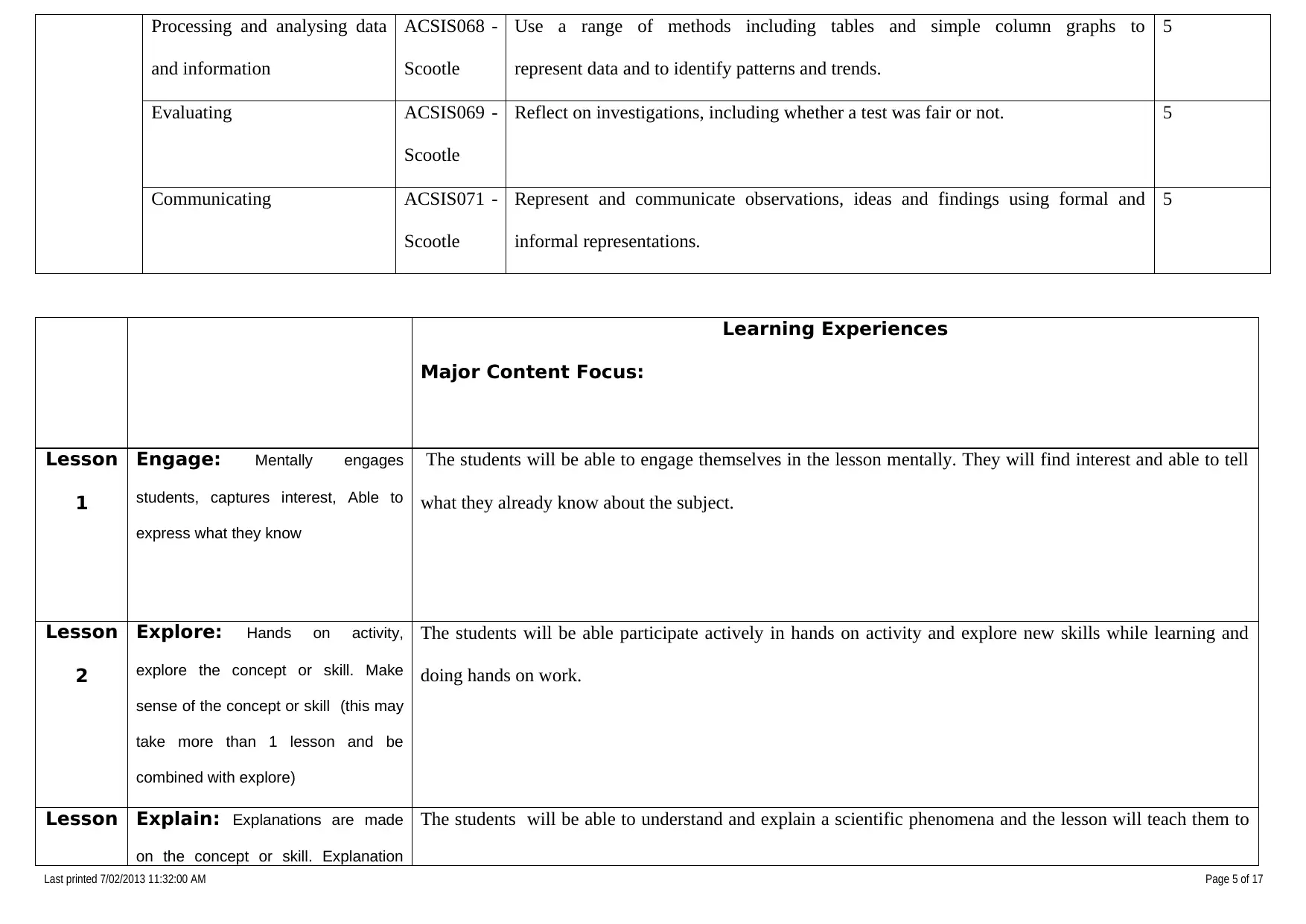
Processing and analysing data
and information
ACSIS068 -
Scootle
Use a range of methods including tables and simple column graphs to
represent data and to identify patterns and trends.
5
Evaluating ACSIS069 -
Scootle
Reflect on investigations, including whether a test was fair or not. 5
Communicating ACSIS071 -
Scootle
Represent and communicate observations, ideas and findings using formal and
informal representations.
5
Learning Experiences
Major Content Focus:
Lesson
1
Engage: Mentally engages
students, captures interest, Able to
express what they know
The students will be able to engage themselves in the lesson mentally. They will find interest and able to tell
what they already know about the subject.
Lesson
2
Explore: Hands on activity,
explore the concept or skill. Make
sense of the concept or skill (this may
take more than 1 lesson and be
combined with explore)
The students will be able participate actively in hands on activity and explore new skills while learning and
doing hands on work.
Lesson Explain: Explanations are made
on the concept or skill. Explanation
The students will be able to understand and explain a scientific phenomena and the lesson will teach them to
Last printed 7/02/2013 11:32:00 AM Page 5 of 17
and information
ACSIS068 -
Scootle
Use a range of methods including tables and simple column graphs to
represent data and to identify patterns and trends.
5
Evaluating ACSIS069 -
Scootle
Reflect on investigations, including whether a test was fair or not. 5
Communicating ACSIS071 -
Scootle
Represent and communicate observations, ideas and findings using formal and
informal representations.
5
Learning Experiences
Major Content Focus:
Lesson
1
Engage: Mentally engages
students, captures interest, Able to
express what they know
The students will be able to engage themselves in the lesson mentally. They will find interest and able to tell
what they already know about the subject.
Lesson
2
Explore: Hands on activity,
explore the concept or skill. Make
sense of the concept or skill (this may
take more than 1 lesson and be
combined with explore)
The students will be able participate actively in hands on activity and explore new skills while learning and
doing hands on work.
Lesson Explain: Explanations are made
on the concept or skill. Explanation
The students will be able to understand and explain a scientific phenomena and the lesson will teach them to
Last printed 7/02/2013 11:32:00 AM Page 5 of 17
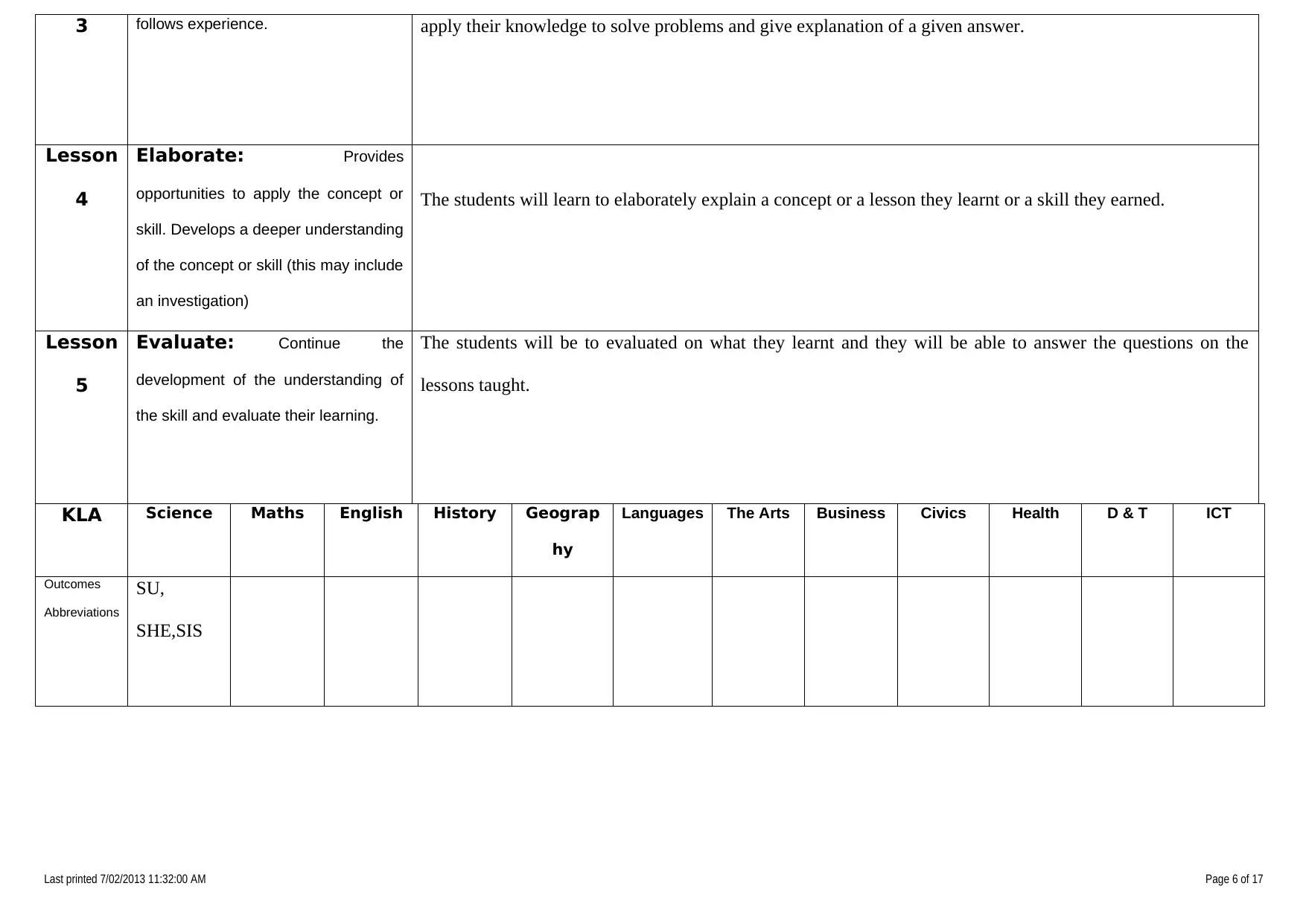
3 follows experience. apply their knowledge to solve problems and give explanation of a given answer.
Lesson
4
Elaborate: Provides
opportunities to apply the concept or
skill. Develops a deeper understanding
of the concept or skill (this may include
an investigation)
The students will learn to elaborately explain a concept or a lesson they learnt or a skill they earned.
Lesson
5
Evaluate: Continue the
development of the understanding of
the skill and evaluate their learning.
The students will be to evaluated on what they learnt and they will be able to answer the questions on the
lessons taught.
KLA Science Maths English History Geograp
hy
Languages The Arts Business Civics Health D & T ICT
Outcomes
Abbreviations
SU,
SHE,SIS
Last printed 7/02/2013 11:32:00 AM Page 6 of 17
Lesson
4
Elaborate: Provides
opportunities to apply the concept or
skill. Develops a deeper understanding
of the concept or skill (this may include
an investigation)
The students will learn to elaborately explain a concept or a lesson they learnt or a skill they earned.
Lesson
5
Evaluate: Continue the
development of the understanding of
the skill and evaluate their learning.
The students will be to evaluated on what they learnt and they will be able to answer the questions on the
lessons taught.
KLA Science Maths English History Geograp
hy
Languages The Arts Business Civics Health D & T ICT
Outcomes
Abbreviations
SU,
SHE,SIS
Last printed 7/02/2013 11:32:00 AM Page 6 of 17
⊘ This is a preview!⊘
Do you want full access?
Subscribe today to unlock all pages.

Trusted by 1+ million students worldwide

Leave this page blank
Last printed 7/02/2013 11:32:00 AM Page 7 of 17
Last printed 7/02/2013 11:32:00 AM Page 7 of 17
Paraphrase This Document
Need a fresh take? Get an instant paraphrase of this document with our AI Paraphraser
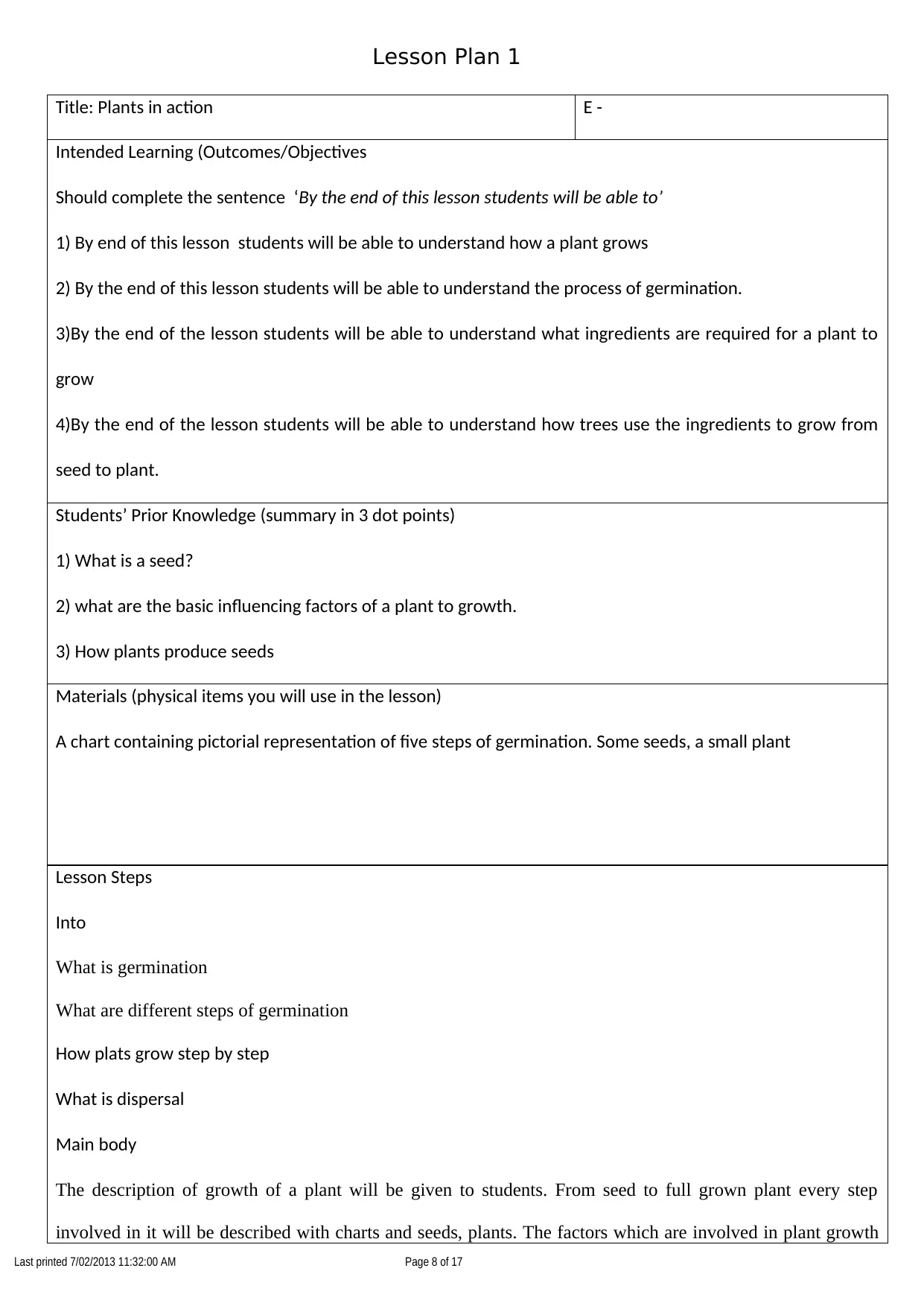
Lesson Plan 1
Title: Plants in action E -
Intended Learning (Outcomes/Objectives
Should complete the sentence ‘By the end of this lesson students will be able to’
1) By end of this lesson students will be able to understand how a plant grows
2) By the end of this lesson students will be able to understand the process of germination.
3)By the end of the lesson students will be able to understand what ingredients are required for a plant to
grow
4)By the end of the lesson students will be able to understand how trees use the ingredients to grow from
seed to plant.
Students’ Prior Knowledge (summary in 3 dot points)
1) What is a seed?
2) what are the basic influencing factors of a plant to growth.
3) How plants produce seeds
Materials (physical items you will use in the lesson)
A chart containing pictorial representation of five steps of germination. Some seeds, a small plant
Lesson Steps
Into
What is germination
What are different steps of germination
How plats grow step by step
What is dispersal
Main body
The description of growth of a plant will be given to students. From seed to full grown plant every step
involved in it will be described with charts and seeds, plants. The factors which are involved in plant growth
Last printed 7/02/2013 11:32:00 AM Page 8 of 17
Title: Plants in action E -
Intended Learning (Outcomes/Objectives
Should complete the sentence ‘By the end of this lesson students will be able to’
1) By end of this lesson students will be able to understand how a plant grows
2) By the end of this lesson students will be able to understand the process of germination.
3)By the end of the lesson students will be able to understand what ingredients are required for a plant to
grow
4)By the end of the lesson students will be able to understand how trees use the ingredients to grow from
seed to plant.
Students’ Prior Knowledge (summary in 3 dot points)
1) What is a seed?
2) what are the basic influencing factors of a plant to growth.
3) How plants produce seeds
Materials (physical items you will use in the lesson)
A chart containing pictorial representation of five steps of germination. Some seeds, a small plant
Lesson Steps
Into
What is germination
What are different steps of germination
How plats grow step by step
What is dispersal
Main body
The description of growth of a plant will be given to students. From seed to full grown plant every step
involved in it will be described with charts and seeds, plants. The factors which are involved in plant growth
Last printed 7/02/2013 11:32:00 AM Page 8 of 17

and how they impact the germination process will be taught. The dispersal process will be taught along with
the various types of dispersal.
Conclusion
Students will have clear idea about plant growth and will be aware about the whole process of germination
and how plants grow from different parts of a plant.
Key Questions to Ask
1) What are the three things that a seed requires to germinate ?
2) What is step farming
3) Why do plants scatter their seeds
4) What is dispersal? What are different steps of it ?
5) Importance of cotyledon of a plant.
Assessment
Student Assessment (type, group, specific links to any rubrics, checklists)
1) Subjective and objective questions
2) Individual assessment
3) https://www.rcampus.com/rubricshowc.cfm?code=YX53545&sp=yes&
4) https://www.nps.gov/timu/learn/education/upload/how-plants-grow-unit-plan.pdf
Must link to lesson outcome/objectives s
Last printed 7/02/2013 11:32:00 AM Page 9 of 17
the various types of dispersal.
Conclusion
Students will have clear idea about plant growth and will be aware about the whole process of germination
and how plants grow from different parts of a plant.
Key Questions to Ask
1) What are the three things that a seed requires to germinate ?
2) What is step farming
3) Why do plants scatter their seeds
4) What is dispersal? What are different steps of it ?
5) Importance of cotyledon of a plant.
Assessment
Student Assessment (type, group, specific links to any rubrics, checklists)
1) Subjective and objective questions
2) Individual assessment
3) https://www.rcampus.com/rubricshowc.cfm?code=YX53545&sp=yes&
4) https://www.nps.gov/timu/learn/education/upload/how-plants-grow-unit-plan.pdf
Must link to lesson outcome/objectives s
Last printed 7/02/2013 11:32:00 AM Page 9 of 17
⊘ This is a preview!⊘
Do you want full access?
Subscribe today to unlock all pages.

Trusted by 1+ million students worldwide

Lesson Plan 2
Title: Platypus life cycle E
Intended Learning (Outcomes/Objectives
Should complete the sentence ‘By the end of this lesson students will be able to’
1)By the end of this lesson students will be able to understand How platypus takes birth and its life cycle
2) By the end of this lesson students will be able to understand how platypus lay eggs and take care of their
babies
3) By the end of this lesson students will be able to understand how people affect platypus habitat.
4) By the end of this lesson students will be able to understand what is food habit of platypus
Students’ Prior Knowledge (summary in 3 dot points)
1) What is a mammal?
2) what is platypus ?
3) why platypus is different from other mammals ?
Materials (physical items you will use in the lesson)
A chart describing life cycle of platypus. Some pictures of platypus.
Lessons Steps
Into
Introduction of a platypus will be given. Why it is considered as mammal will be described. The overview
of the life cycle will be given
Main Body
The lesson will cover the platypus life cycle description and details about the reproduction of the platypus
along with how they take care of their babies, food habits and so on. How the platypus habitats are affected
by people that will also be discussed.
Last printed 7/02/2013 11:32:00 AM Page 10 of 17
Title: Platypus life cycle E
Intended Learning (Outcomes/Objectives
Should complete the sentence ‘By the end of this lesson students will be able to’
1)By the end of this lesson students will be able to understand How platypus takes birth and its life cycle
2) By the end of this lesson students will be able to understand how platypus lay eggs and take care of their
babies
3) By the end of this lesson students will be able to understand how people affect platypus habitat.
4) By the end of this lesson students will be able to understand what is food habit of platypus
Students’ Prior Knowledge (summary in 3 dot points)
1) What is a mammal?
2) what is platypus ?
3) why platypus is different from other mammals ?
Materials (physical items you will use in the lesson)
A chart describing life cycle of platypus. Some pictures of platypus.
Lessons Steps
Into
Introduction of a platypus will be given. Why it is considered as mammal will be described. The overview
of the life cycle will be given
Main Body
The lesson will cover the platypus life cycle description and details about the reproduction of the platypus
along with how they take care of their babies, food habits and so on. How the platypus habitats are affected
by people that will also be discussed.
Last printed 7/02/2013 11:32:00 AM Page 10 of 17
Paraphrase This Document
Need a fresh take? Get an instant paraphrase of this document with our AI Paraphraser
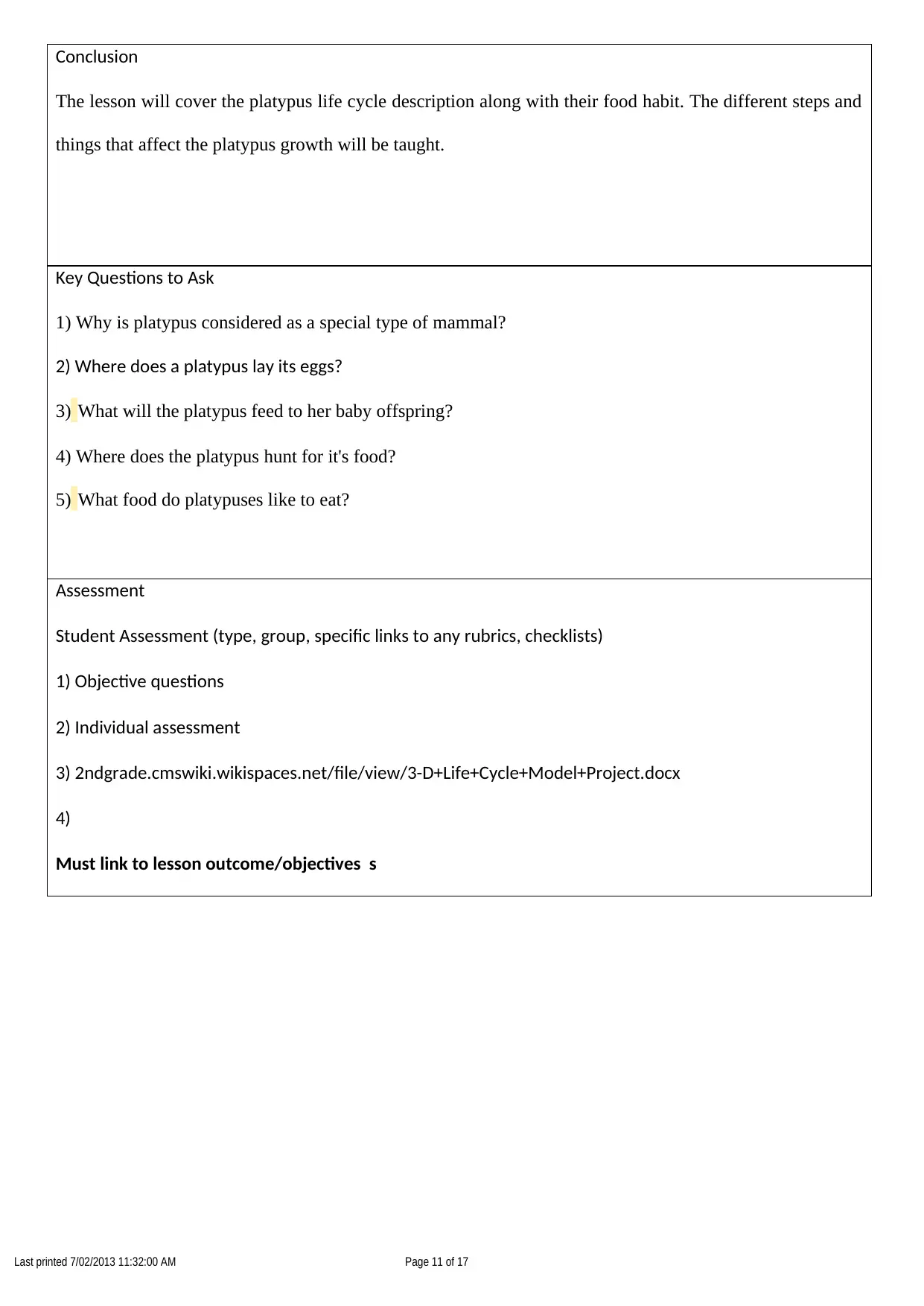
Conclusion
The lesson will cover the platypus life cycle description along with their food habit. The different steps and
things that affect the platypus growth will be taught.
Key Questions to Ask
1) Why is platypus considered as a special type of mammal?
2) Where does a platypus lay its eggs?
3) What will the platypus feed to her baby offspring?
4) Where does the platypus hunt for it's food?
5) What food do platypuses like to eat?
Assessment
Student Assessment (type, group, specific links to any rubrics, checklists)
1) Objective questions
2) Individual assessment
3) 2ndgrade.cmswiki.wikispaces.net/file/view/3-D+Life+Cycle+Model+Project.docx
4)
Must link to lesson outcome/objectives s
Last printed 7/02/2013 11:32:00 AM Page 11 of 17
The lesson will cover the platypus life cycle description along with their food habit. The different steps and
things that affect the platypus growth will be taught.
Key Questions to Ask
1) Why is platypus considered as a special type of mammal?
2) Where does a platypus lay its eggs?
3) What will the platypus feed to her baby offspring?
4) Where does the platypus hunt for it's food?
5) What food do platypuses like to eat?
Assessment
Student Assessment (type, group, specific links to any rubrics, checklists)
1) Objective questions
2) Individual assessment
3) 2ndgrade.cmswiki.wikispaces.net/file/view/3-D+Life+Cycle+Model+Project.docx
4)
Must link to lesson outcome/objectives s
Last printed 7/02/2013 11:32:00 AM Page 11 of 17
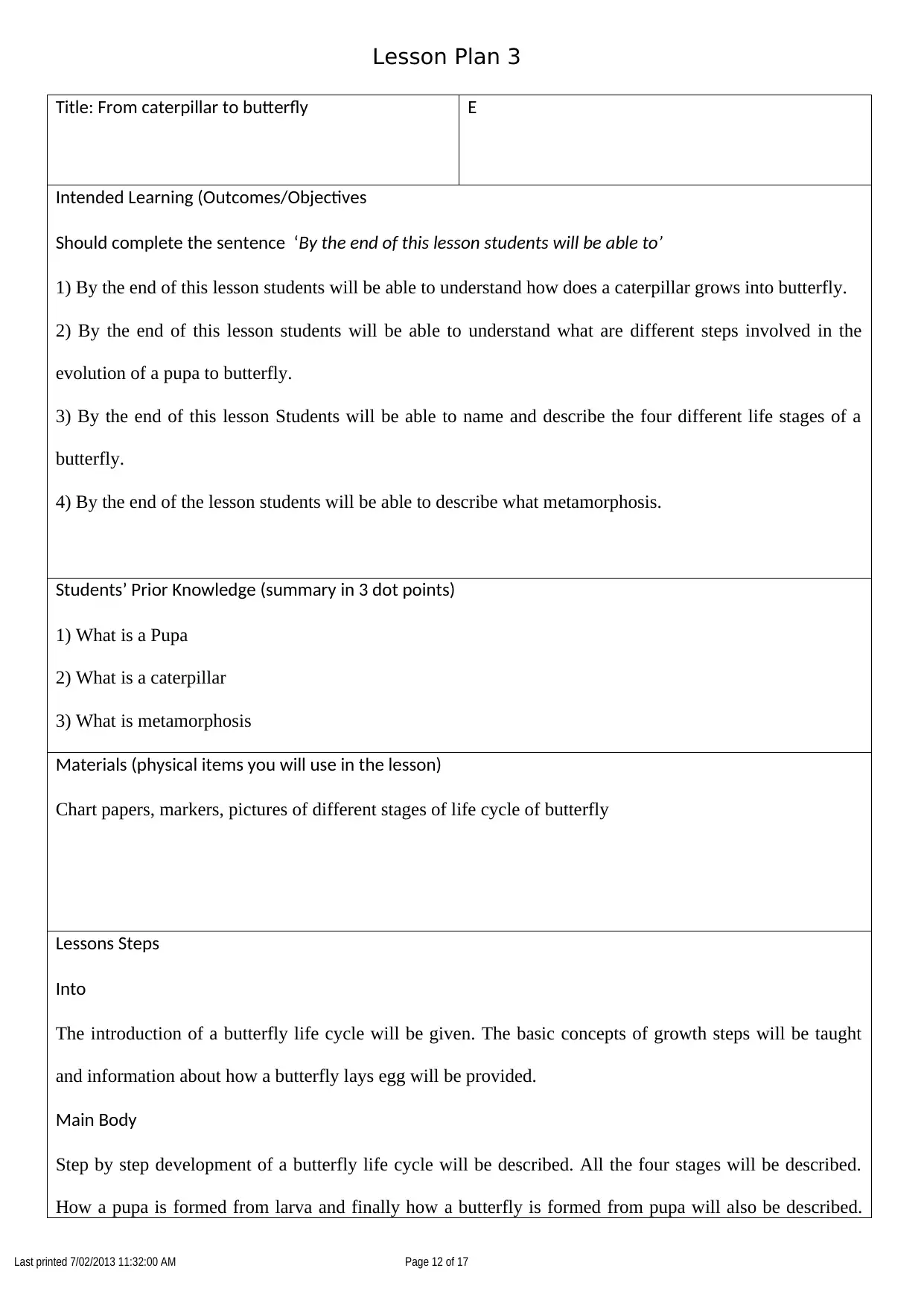
Lesson Plan 3
Title: From caterpillar to butterfly E
Intended Learning (Outcomes/Objectives
Should complete the sentence ‘By the end of this lesson students will be able to’
1) By the end of this lesson students will be able to understand how does a caterpillar grows into butterfly.
2) By the end of this lesson students will be able to understand what are different steps involved in the
evolution of a pupa to butterfly.
3) By the end of this lesson Students will be able to name and describe the four different life stages of a
butterfly.
4) By the end of the lesson students will be able to describe what metamorphosis.
Students’ Prior Knowledge (summary in 3 dot points)
1) What is a Pupa
2) What is a caterpillar
3) What is metamorphosis
Materials (physical items you will use in the lesson)
Chart papers, markers, pictures of different stages of life cycle of butterfly
Lessons Steps
Into
The introduction of a butterfly life cycle will be given. The basic concepts of growth steps will be taught
and information about how a butterfly lays egg will be provided.
Main Body
Step by step development of a butterfly life cycle will be described. All the four stages will be described.
How a pupa is formed from larva and finally how a butterfly is formed from pupa will also be described.
Last printed 7/02/2013 11:32:00 AM Page 12 of 17
Title: From caterpillar to butterfly E
Intended Learning (Outcomes/Objectives
Should complete the sentence ‘By the end of this lesson students will be able to’
1) By the end of this lesson students will be able to understand how does a caterpillar grows into butterfly.
2) By the end of this lesson students will be able to understand what are different steps involved in the
evolution of a pupa to butterfly.
3) By the end of this lesson Students will be able to name and describe the four different life stages of a
butterfly.
4) By the end of the lesson students will be able to describe what metamorphosis.
Students’ Prior Knowledge (summary in 3 dot points)
1) What is a Pupa
2) What is a caterpillar
3) What is metamorphosis
Materials (physical items you will use in the lesson)
Chart papers, markers, pictures of different stages of life cycle of butterfly
Lessons Steps
Into
The introduction of a butterfly life cycle will be given. The basic concepts of growth steps will be taught
and information about how a butterfly lays egg will be provided.
Main Body
Step by step development of a butterfly life cycle will be described. All the four stages will be described.
How a pupa is formed from larva and finally how a butterfly is formed from pupa will also be described.
Last printed 7/02/2013 11:32:00 AM Page 12 of 17
⊘ This is a preview!⊘
Do you want full access?
Subscribe today to unlock all pages.

Trusted by 1+ million students worldwide
1 out of 16
Related Documents
Your All-in-One AI-Powered Toolkit for Academic Success.
+13062052269
info@desklib.com
Available 24*7 on WhatsApp / Email
![[object Object]](/_next/static/media/star-bottom.7253800d.svg)
Unlock your academic potential
Copyright © 2020–2025 A2Z Services. All Rights Reserved. Developed and managed by ZUCOL.





